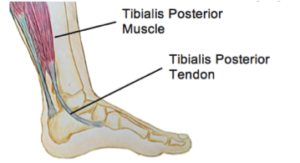The tibialis posterior muscle sits just inside the shin, halfway up the lower leg. The muscle travels downwards and runs along the inside of the heel, with the tendon attaching at the base of the arch of the foot.
The role of the tibialis posterior muscle is to move the foot and ankle downwards and towards the midline of the body. The tibialis posterior also helps to support and maintain the arch of the foot. Tendinopathy is a broad term that refers to painful pathologies of the tissues in and around a tendon, usually related to overuse.
What are the symptoms?
Signs and symptoms of tibialis posterior tendinopathy can include pain and/or stiffness over the tendon, clicking or ‘crepitus’ sounds with movement and swelling. Pain can be felt both when you touch the tendon or with movements that involve contraction of the tibialis posterior muscle, such as when going up on to your toes, hopping or running.
As the condition progresses, the tendon might be come weaker and elongated, providing less support to the arch of the foot. This might become more noticeable over time as the lack of support in the foot further aggravates the damaged tendon.
Pain may become so severe that eventually running becomes too painful to continue and even walking may be sore. In some cases, the affected tendon may be weakened but painless. For some, a complete tear of a weakened tendon can be the first sign that anything is wrong.
What are the causes?
Like most tendinopathies, overuse and biomechanical errors are the main cause of tendon pathology. Prolonged or repetitive activities that place excessive strain on the tibialis posterior tendon can cause degeneration and disorganization of collagen fibres within the tendon.
Excessive pronation or rolling in of the foot while walking can place the tendon under extra stress as it acts to support the arch. Unsupportive footwear can exacerbate this process as it allows the foot to roll inwards. Often, a person may not have any issues until they begin to increase their training. If tendons are subjected to too much load too quickly, they can begin to breakdown, developing into a tendinopathy.
Being overweight, muscle weakness or tightness, poor warm up and insufficient recovery periods can all contribute to the development of tendinopathy. As you might expect, runners are most affected by this condition, along with other athletes of sports that require lots of running. Non- athletes can also be affected with day-to-day activities causing tendinopathy.
How can physiotherapy help?
Your physiotherapist can help by making an accurate diagnosis in clinic, which can be confirmed by MRI or ultrasound. Your physiotherapist can also identify which factors may be involved in the development of this condition, helping to address them and reduce pain as quickly as possible.
For most tendinopathies, a period of relative rest is required and a graded training program to help strengthen the tendon has been shown to have the best evidence for recovery. Other interventions such as ultrasound, ice or heat treatment, soft tissue massage, stretching and joint mobilization may be used. Arch support taping, biomechanical correction, bracing and footwear advice may also be added.
None of the information in this blog is a replacement for proper medical advice. Always see a medical professional for advice on your individual injury.

